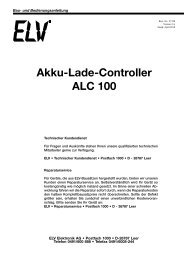Akku-Lade-Center Battery Charging Centre ALC 8500-2 ... - Batimex
Akku-Lade-Center Battery Charging Centre ALC 8500-2 ... - Batimex
Akku-Lade-Center Battery Charging Centre ALC 8500-2 ... - Batimex
Sie wollen auch ein ePaper? Erhöhen Sie die Reichweite Ihrer Titel.
YUMPU macht aus Druck-PDFs automatisch weboptimierte ePaper, die Google liebt.
However, these transfer resistances generally remain<br />
unchanged relative to each other. For this reason it<br />
is always worthwhile carrying out an optimisation<br />
process in any high-current application. This involves<br />
eliminating unnecessary connectors, and using short<br />
cables of generous cross-section wherever possible.<br />
All connectors should exhibit a large contact area<br />
and be a firm, secure fit. In principle the method of<br />
measuring internal resistance is extremely simple:<br />
the battery is discharged at a high, carefully defined<br />
current, and the voltage decline compared to the<br />
unloaded state is measured. The internal resistance<br />
can then be calculated by dividing the voltage difference<br />
by the load current.<br />
Fig. 1: Special measuring cables with springloaded<br />
probes<br />
In practice the process is not quite so simple: on the one hand the voltage differences are very small<br />
- in the Millivolts range - and on the other hand the charger has to be capable of absorbing the high<br />
discharge current and the dissipated power, even when the duration of the current pulse is brief. A<br />
further difficulty is the fact that informative results can only be achieved if the voltage is measured<br />
directly at the battery terminals, otherwise voltage fall-off in the measurement cables would seriously<br />
falsify the result. To fulfil these requirements, special measurement cables (optional) are used, each<br />
wire featuring two spring-loaded probes (Fig. 1). These probes make reliable contact with the terminal<br />
caps of the battery (or other desired measurement points). The pulse of discharge current flows through<br />
the broad contacts of the measurement cables, and the second contact is used to record the measurement<br />
directly at the terminal caps of the battery.<br />
If you wish to include the losses caused by cables and connectors in the resistance measurement,<br />
then simply position the probes at the appropriate points. The spring-loaded probes ensure reliable<br />
electrical contact at all four measurement points.<br />
Important note:<br />
It is in the nature of the battery Ri measurement process that it is impossible to provide reversed<br />
polarity protection. Please take care, as connecting a battery with reversed polarity can cause damage.<br />
39



